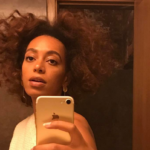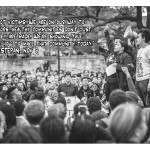On Thursday, January 26 at 9PM, the Yale Law School Levinson Auditorium hosted the sold out event “Everybody Still Wants to Fly: Activism in Pop from Prince to Solange,” part of a four day conference celebrating the legacies of Prince and David Bowie. Though the event was sold out because it featured Solange Knowles as a keynote speaker, it began with a panel on Prince’s activism in music, with authors Alan Light and Kandia Crazy Horse as speakers. The title “Everybody Still Wants to Fly” was originally a lyric from Prince’s “Sign O’ the Times,” reflecting that after a rocket ship explodes, or any other catastrophe occurs, human determination still outweighs doubt and fear. While moderator and conference organizer Daphne Brooks was well aware that most of her audience was waiting for a glimpse of Solange Knowles, she maintained that it was important for millennials to know Prince’s genius, especially during what she called a national “moment of questioning.”
As a millennial with little knowledge or opinion on Prince, I couldn’t call the introduction panel completely unnecessary. Between performance footage of iconic Prince songs such as “If I Was Your Girlfriend” and “Housequake,” Light and Crazy Horse guided us through Prince’s eccentric stage presence and iconic divergence from black masculinity. However, at times the conversation was difficult to understand. For instance, Crazy Horse’s analysis of Prince’s lyrics and performance focused on occultism and sorcery, and often used language far too esoteric for what was supposed to be an introduction to Prince for those who knew very little about him. The misplaced complexity of the panel also made it long-winded, carrying the event half an hour off schedule. Even the panelists themselves were aware they were not the main event, Light joking in his opening remarks that he was “happy to be opening for Solange.”
When Solange Knowles finally entered the auditorium, the cheers and camera flashes that erupted really did make it seem as if the concert headliner had finally appeared. Even Brooks became flustered while asking Knowles permission to play a music video on the projector, blurting out, “I’ll do anything you want.” However, as the keynote conversation continued, Knowles proved to be just as overwhelmed with her new star status, recounting her disbelief at the Inauguration Peace Ball when someone gave her the message that Angela Davis wanted to meet her. Unlike Prince, Knowles does not feel full confidence in all of her live performances. But like Prince, she prioritizes creative control and originality above all.
Knowles recalled the early years of her career, struggling to catch on to the hip hop dance moves of Destiny’s Child that didn’t quite match her training in modern dance. As a teenager, she resisted managers that wanted her to be a pop sensation, and into her adult career still had trouble fitting her sound and aesthetic into R&B or pop. She pulled much of her inspiration for her album from “The Wiz,” a modern version of “The Wizard of Oz” performed by an all-black cast. In songs such as “Mad” she wanted to be angry about injustice and misogynoir, whereas female R&B artists have only been allowed to perform anger as a reaction to an unfaithful lover. “Everything does not relate to no nigga,” Knowles said, to laughter and applause from the auditorium.
While it took her eight years to write “A Seat at the Table,” Knowles stands by her resistance to following the metaphorical handbook Prince himself never followed. She recounted a friend telling her that the soft, pastel aesthetic of “Cranes in the Sky” was antiblack, and that the style of her video was only for white art, part of a direction she was not allowed to take in protest art. However, Knowles felt that experimental culture often used by white artists was just as much her right to use as anyone else. “I have to create from the ground up,” she said, “in the space I want to exist in.” While Knowles does not resist in a way that is immediately legible, her soft visual aesthetics, graceful modern dance, and use of the female falsetto are her own form of protest art. By choosing the space she wants to build in and ignoring the rules that dictate her place as a black female artist, Knowles may indeed be pushing back against the style that even her sister Beyonce Knowles performs, but she is standing her ground in a music industry that continues to commodify black femininity and black voices. By diverging from expectation, Knowles is indeed continuing the work of Prince and will pave the way for activism in music in this time of questioning, and onward.



